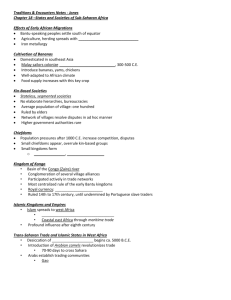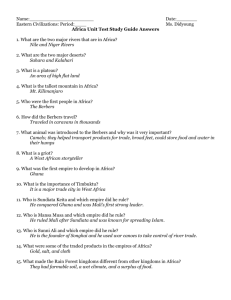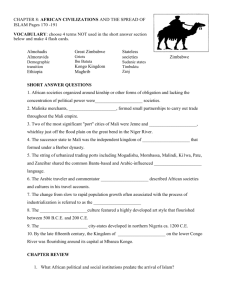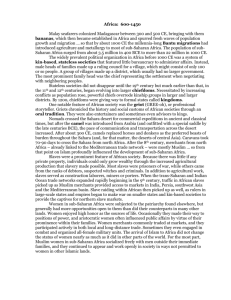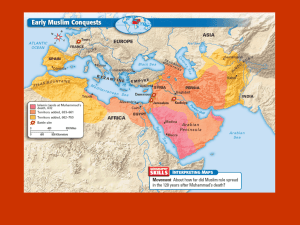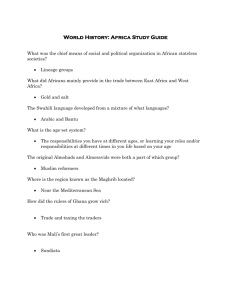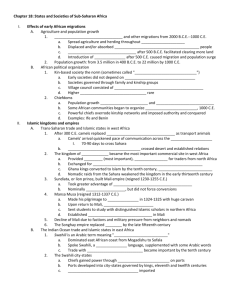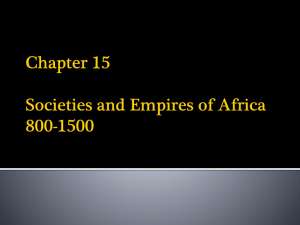organized kinship
advertisement
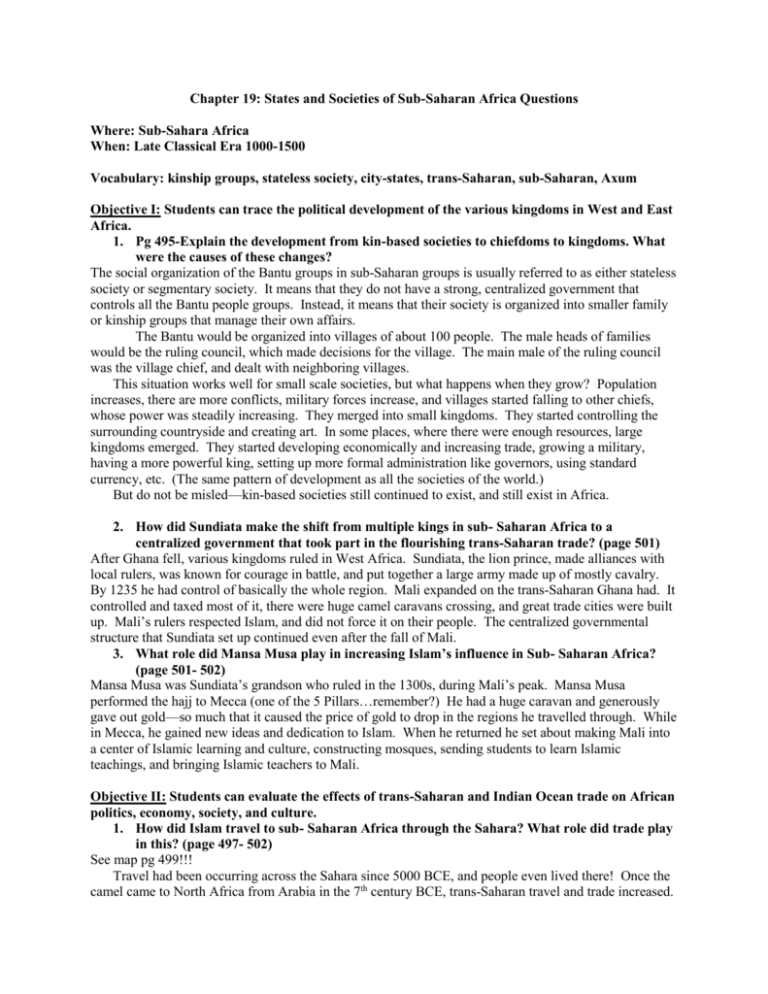
Chapter 19: States and Societies of Sub-Saharan Africa Questions Where: Sub-Sahara Africa When: Late Classical Era 1000-1500 Vocabulary: kinship groups, stateless society, city-states, trans-Saharan, sub-Saharan, Axum Objective I: Students can trace the political development of the various kingdoms in West and East Africa. 1. Pg 495-Explain the development from kin-based societies to chiefdoms to kingdoms. What were the causes of these changes? The social organization of the Bantu groups in sub-Saharan groups is usually referred to as either stateless society or segmentary society. It means that they do not have a strong, centralized government that controls all the Bantu people groups. Instead, it means that their society is organized into smaller family or kinship groups that manage their own affairs. The Bantu would be organized into villages of about 100 people. The male heads of families would be the ruling council, which made decisions for the village. The main male of the ruling council was the village chief, and dealt with neighboring villages. This situation works well for small scale societies, but what happens when they grow? Population increases, there are more conflicts, military forces increase, and villages started falling to other chiefs, whose power was steadily increasing. They merged into small kingdoms. They started controlling the surrounding countryside and creating art. In some places, where there were enough resources, large kingdoms emerged. They started developing economically and increasing trade, growing a military, having a more powerful king, setting up more formal administration like governors, using standard currency, etc. (The same pattern of development as all the societies of the world.) But do not be misled—kin-based societies still continued to exist, and still exist in Africa. 2. How did Sundiata make the shift from multiple kings in sub- Saharan Africa to a centralized government that took part in the flourishing trans-Saharan trade? (page 501) After Ghana fell, various kingdoms ruled in West Africa. Sundiata, the lion prince, made alliances with local rulers, was known for courage in battle, and put together a large army made up of mostly cavalry. By 1235 he had control of basically the whole region. Mali expanded on the trans-Saharan Ghana had. It controlled and taxed most of it, there were huge camel caravans crossing, and great trade cities were built up. Mali’s rulers respected Islam, and did not force it on their people. The centralized governmental structure that Sundiata set up continued even after the fall of Mali. 3. What role did Mansa Musa play in increasing Islam’s influence in Sub- Saharan Africa? (page 501- 502) Mansa Musa was Sundiata’s grandson who ruled in the 1300s, during Mali’s peak. Mansa Musa performed the hajj to Mecca (one of the 5 Pillars…remember?) He had a huge caravan and generously gave out gold—so much that it caused the price of gold to drop in the regions he travelled through. While in Mecca, he gained new ideas and dedication to Islam. When he returned he set about making Mali into a center of Islamic learning and culture, constructing mosques, sending students to learn Islamic teachings, and bringing Islamic teachers to Mali. Objective II: Students can evaluate the effects of trans-Saharan and Indian Ocean trade on African politics, economy, society, and culture. 1. How did Islam travel to sub- Saharan Africa through the Sahara? What role did trade play in this? (page 497- 502) See map pg 499!!! Travel had been occurring across the Sahara since 5000 BCE, and people even lived there! Once the camel came to North Africa from Arabia in the 7th century BCE, trans-Saharan travel and trade increased. As Islam merchants traveled up from Arabia into Africa, they gradually expanded the trade to cross the whole Sahara desert, where they connected with the West African trade networks already in place. The existent state when the Muslims arrived there was the kingdom of Ghana. The new trade helped Ghana become a booming center of commerce. Ghana traded gold from neighboring kingdoms, ivory, and slaves for horses, cloth, manufactured goods, and salt from the Muslims. Mosques began to be built and qadi and Muslim scholars were brought in. The kings converted to Islam, which of course improved their relations with the Muslim traders and states of North Africa. They did not force their subjects to convert, and they even kept some of their traditional religious customs like magic and idols. Eventually Ghana fell due to attacks from nomadic people groups from the Sahara. 2. Describe how the Indian Ocean trade affected east and central Africa. (page 502-505) Indians and Persians had been visiting east Africa since 500 BCE, but they didn’t trade much since the societies in east Africa at that time were mostly hunter-gatherers, and hadn’t established much civilization yet. But when the Bantu migrated to east Africa, they started civilizations and trade. Their society came to be known as Swahili, which is an Arabic word meaning “coasters”. It is an African culture with Arab influences. The maritime trade between the Africans and Muslims increased: with gold, slaves, ivory, and exotic goods from Africa trading for pottery, glass, and textiles from Muslims. In east Africa, the increasing trade helped chiefs gain authority. Large trading cities were set up, and their kings grew powerful. The cities had large fancy mosques and buildings. The elites dressed in fine clothes and had luxury goods. In central Africa, powerful and wealthy kingdoms were established as well, though not as wealthy as east Africa. The best known of these was Zimbabwe. They used stone, instead of wood, which indicates more wealth. They built a huge circular structure called Great Zimbabwe (it was 16 feet thick and 32 feet tall.) The kings of Great Zimbabwe controlled the trade of that region, which allowed them to form allies and make huge profits. attacks by nomadic peoples from the Sahara. 3. How did Islam travel to Sub- Saharan Africa through the Indian Ocean? (page 505) The Muslim merchants spread their religion of Islam down the coast, and the African peoples gradually adopted it, but mixed it with their own native customs. The elites converted, but continued their own religious and cultural traditions, to set an example for the people. But their conversion to Islam allowed them to cooperate more with the Muslim merchants. Furthermore, Islamic states in SW Asia supported them, which gave the elites in Africa legitimacy. Islam gradually grew and more people accepted it. Objective III: Students can analyze the native African cultural features, and explain how Islam and Christianity changed or did not change the African culture when it arrived. 1. Characterize the social structure and values of a kin-based society, including expectations pertaining to kinship, gender, and age. (page 507- 508) The main form of social organization in kin-based society is the family/tribe. Private property did not exist; a whole community would share its resources. Villages were made up of several extended families, and the ruling council (see above) would distribute resources to the families. Gender determined what you did. Men would clear land and do heavy labor. Both men and women planted and harvested crops. Women mostly did the household duties and raised the children. But, even though men had the leadership roles, women were better off in these small societies. They were respected as sources of life, they could hold leadership positions, and they could influence their own families strongly. They traded in markets as well as in long-distance trade. There were even sometimes allfemale military units! When Islam came, it did not change the status of women here, like it did in Arabia and SW Asia. Those cultures already were more patriarchal than in Africa. Here the women were free to do more: socialize with men, work openly in society, and do other things that women in other Islamic societies could not do. (Get it girls! That’s what I’m talking about) People were also organized into age groups. A certain age would unite together, crossing family boundaries, and they had roles in society according to their age—performing certain tasks together according to age. 2. Describe the Islamic-African slave trade of this time and the effects it had on Africa. (page 508- 509) Slavery had existed in Africa, JUST LIKE EVERYWHERE ELSE, for thousands of years. Most were war captives, or people in debt, people accused of witchcraft, and criminals. Most worked in agriculture, but many also were in construction or mining. Since people did not have private property, slaves were important signs of wealth because people could own those. (Weird right?) And since slaves also produced more crops, it improved the owners’ positions in society. As trade increased, so did slave trade. They were shipped to India, Persia, SW Asia, and the Mediterranean. THESE PLACES HAD PREVIOUSLY GOTTEN THEIR SLAVES FROM EASTERN EUROPE---IT WAS NOT ALWAYS AFRICANS!!!!! African rulers started raiding villages and taking captive people to trade them as slaves. Sometimes the slaves revolted, but these were quickly subdued. The slave trade was enormous—between 750-1500, over 10,000,000 slaves were shipped out. 3. Explain basic features of African religious beliefs. There were many different religions all across Africa, but certain features were shared among them. Many people were monotheistic initially, but adopted new gods later on. Most African believed in a main god who created the world and maintains order. Some saw him as all-powerful and all-knowing. The lesser gods were spirits associated with the sun, wind, rain, trees, rives, etc. They participated actively in the world, making things happen here on earth. Africans also believed that their ancestors’ souls actively worked on the earth as well, so they honored their ancestors in order to get them to help them. Rituals included prayers, animal sacrifices and animals at milestones in life like birth, marriage, death, etc. Religious authorities were diviners, who would consult spirits on behalf of people. If something bad was happening, like disease, the people would have the diviner ask the spirits what was wrong and what they could do to fix it. Thus, African religions were not centered on religious thought, but on its practical application to life: nature, events, relationships, etc. and how they could make it better. 4. Explain how the permeation of both Christianity and Islam through Africa are example of syncretism. (page 511- 513) Christianity entered Africa from the north in the 1st century. It didn’t take hold except for in a few places for a while. But then in the 4th century, Christianity gained more ground in Axum, which is in the highlands of modern Ethiopia. The 1st converts were…you guessed it…merchants, who traded with Christians from overseas. Then came…missionaries, who eventually led to the kings of Axum converting, maybe to improve their relations with the Christians. (They converted even before Constantine in Rome.) The missionaries established monasteries, translated the Bible, and started spreading Christianity. It quickly grew and gained followers. But, since it was isolated from other Christian lands, it developed differently. It mixed with African beliefs: like evil spirits in the world, using charms for protection, and having churches built out of rock. Ethiopian Christians didn’t reconnect with Christians from other lands until the Portuguese went there in the 16th century! In west and east Africa, ruling elites converted to Islam because it helped their position with the Muslim traders. But, they also genuinely believed the faith and built mosques, founded schools, invited Islamic legal scholars, and promulgated the faith. Like Christianity, Islam mixed with African customs. They still believed in evil spirits and witches, and performed rituals to honor nature deities and ancestors’ spirits. As above, women also were freer and more open in Africa, having conversations with any man and dressing only in loincloths. Islam was more added onto African beliefs; it did not completely replace them.

